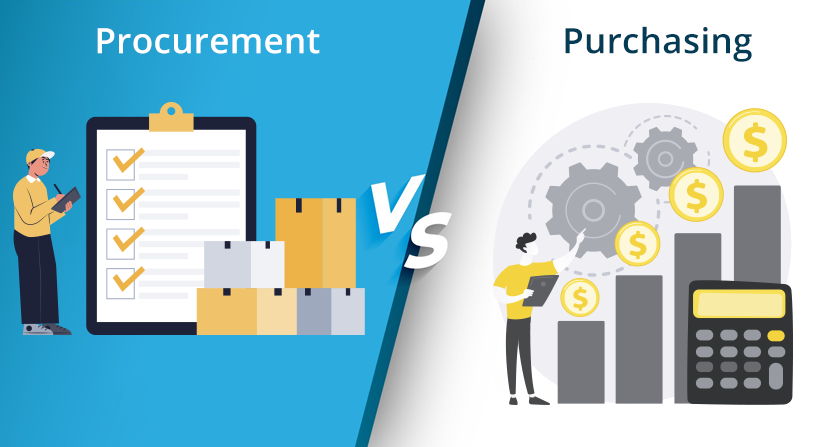So what is procurement? Procurement is acquiring goods, services, or works from an external source. It involves sourcing, negotiation, ordering, delivery, and payment for goods or services. Procurement can be done by a government agency, a private organization, or an individual, and it can involve purchasing anything from pencils to complex machinery. Often, purchasing is used interchangeably with procurement, but purchasing is just one part of the procurement process, precisely the act of buying goods or services.
What Are the Types of Procurement?
Procurement is a complex process that requires careful planning and execution to ensure that the goods or services acquired meet the company’s needs and requirements. Below are the procurement types:
Direct procurement refers to acquiring goods, services, or works directly related to producing a company’s products or services. This type of procurement involves purchasing raw materials, components, and finished goods from suppliers. Direct procurement is critical for manufacturing companies as it enables them to obtain the necessary inputs to produce their products. The main objective of direct procurement is to ensure that the company has a reliable supply of high-quality materials at the lowest possible cost.
Indirect procurement refers to acquiring goods or services not directly related to producing a company’s products or services. This type of procurement includes purchasing office supplies, IT equipment, marketing services, and other non-production-related items. Indirect procurement is essential for the smooth functioning of a company’s operations, as it ensures that the necessary resources are available to support the organization’s day-to-day activities.
Goods procurement involves the acquisition of physical products or materials necessary for the operation of a business or organization. The procurement process can be complex, involving various steps such as identifying the need for the goods, researching potential suppliers, negotiating contracts, and managing inventory. Effective goods procurement is crucial for ensuring a company has the necessary resources to meet its operational needs while managing costs and maintaining quality standards.
Services procurement refers to acquiring services needed to support business operations. This can include services such as consulting, legal advice, marketing, and IT support. The procurement process for services may involve identifying the business’s specific needs, researching potential service providers, negotiating contracts, and managing the delivery of services. Effective services procurement can help a company access specialized expertise, improve operational efficiency, and control costs by ensuring services are obtained at competitive rates.
Steps of the Procurement Process
1. Needs Identification
The key to optimizing this stage is ensuring the requirements are clear, precise, and measurable. This will help in identifying suitable suppliers and in evaluating the proposals.
2. Specification
Once the needs have been identified, the next step is to define the specifications or requirements for the needed goods, services, or works. This could include factors such as quality, quantity, delivery time, cost, and other conditions the organization may have. Clear and detailed specifications will help suppliers to understand what is required and how to meet the requirements. Therefore, the document should include all relevant information, such as technical specifications, performance standards, and delivery requirements.
3. Supplier Identification
The third step is identifying potential suppliers who meet the organization’s requirements. This could involve researching potential suppliers, reviewing industry publications, or seeking recommendations from colleagues or other businesses. A comprehensive supplier database should be created and updated regularly to identify suitable suppliers. This database should include supplier capabilities, experience, quality, and financial stability information.
4. Request for Quotation (RFQ) or Request for Proposal (RFP)
This step involves sending a document to potential suppliers that outlines the organization’s requirements and asks for their proposed solution and price. This could include a detailed list of requirements, a timeline for delivery, and any other relevant information. The request should be clear, concise, and include all necessary information. This will ensure that suppliers can provide accurate and relevant proposals. Use standardized templates to facilitate a fair and consistent evaluation process.
5. Evaluation
Once proposals have been received, the next step is to evaluate them and select the best solution. This could involve reviewing the proposals against the requirements and specifications, conducting site visits or reference checks, and reviewing the supplier’s financial stability and history. Use objective and transparent criteria to evaluate proposals. This will help identify the most suitable supplier to deliver the required goods or services at the best price and quality.
6. Negotiation
After selecting the best supplier, the next step is to negotiate the terms and conditions of the contract. This could include discussions around price, delivery times, warranties, and other contractual representations. Negotiate based on value rather than just price. Understand the supplier’s cost structure, and identify opportunities for cost savings. Also, be willing to compromise on specific terms to achieve overall value.
7. Contract Award
Once the negotiations are complete and both parties agree on the terms and conditions, the contract can be awarded to the chosen supplier. Ensure the contract is awarded to the most suitable supplier who meets all the requirements and has demonstrated the ability to deliver. The contract should clearly outline all terms and conditions, including payment terms, delivery schedules, and performance requirements.
8. Contract Management
The final step is to manage the contract throughout its lifecycle. This could include monitoring supplier performance, ensuring that all contractual obligations are met, managing any changes or disputes, and conducting regular reviews to ensure the contract meets the organization’s needs.
Monitor the performance of the supplier throughout the contract period. Identify any issues or risks early and take corrective action as necessary. Also, maintain good communication with the supplier and ensure all parties meet their contract obligations.
How ERP Helps With Procurement
Enterprise Resource Planning (ERP) systems can optimize procurement by streamlining and automating the procurement process, providing greater visibility, control, and accurate reporting for data-driven decision-making. It also helps establish a more robust supply chain and uses procurement management best practices. Here are some specific ways in which ERP can help with procurement:
- Streamlining procurement processes
- Managing supplier relationships
- Inventory management
- Cost management
- Compliance management
Conclusion
Procurement plays a critical role in the success of an organization. Effective procurement can ensure that the organization has the goods, services, or works it needs to operate efficiently and effectively while also achieving cost savings and maximizing value for money. Organizations can develop a robust procurement strategy that supports their goals and objectives by understanding the procurement process, the types of procurement, and the essential functions and benefits of procurement management. In addition, an ERP system streamlines and optimizes procurement workflow and improves productivity across an organization. Whether you’re a small business owner or a procurement professional in a large organization, understanding procurement and using the right tools can help you make informed decisions and achieve better outcomes.
Follow Us





